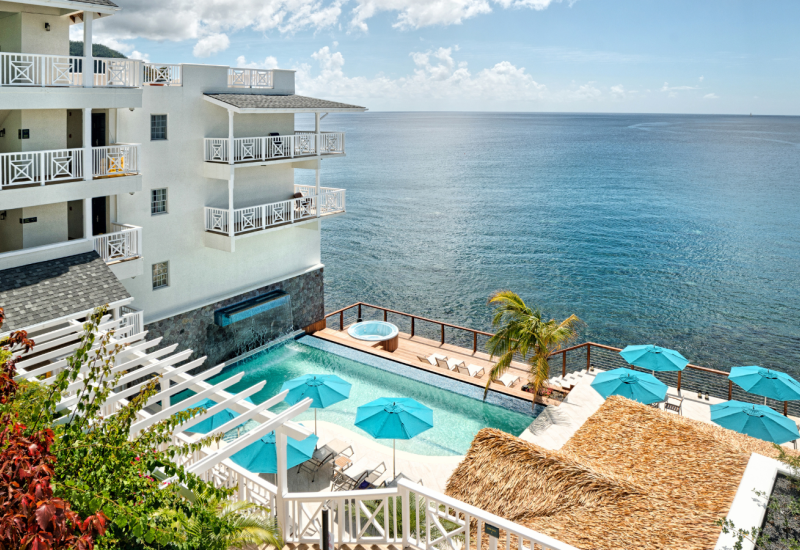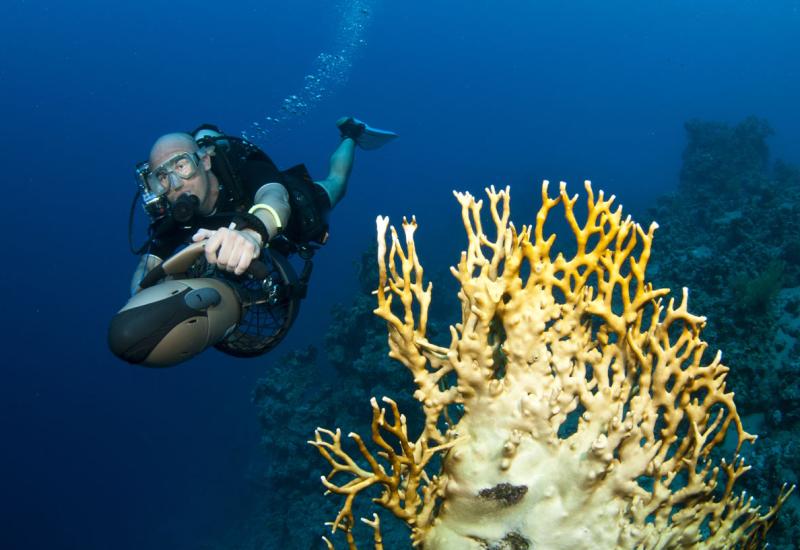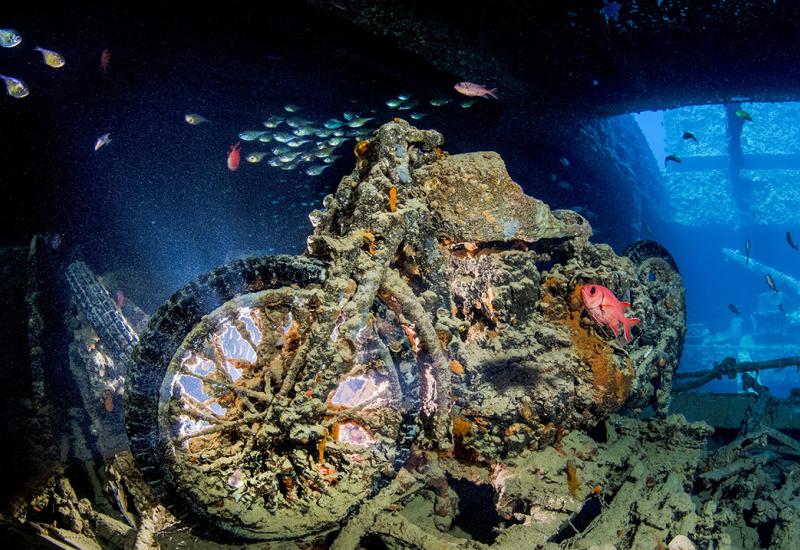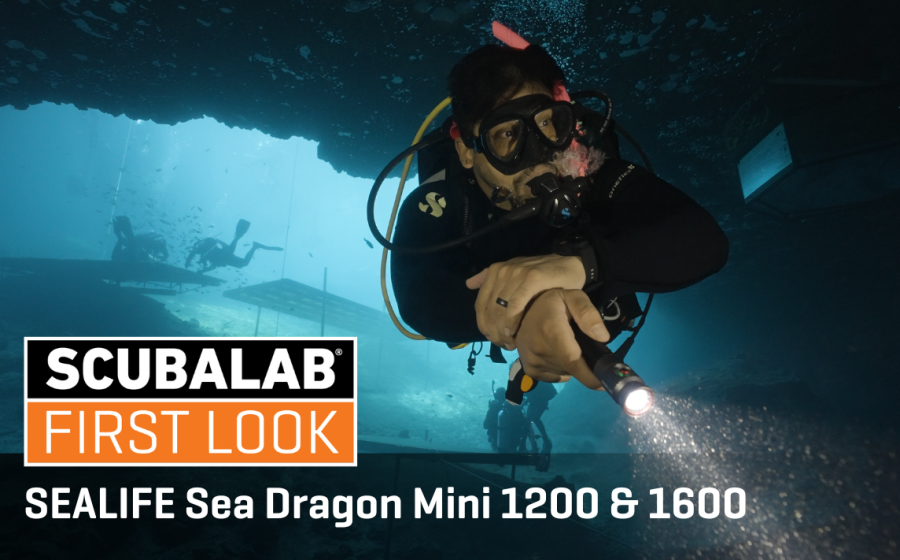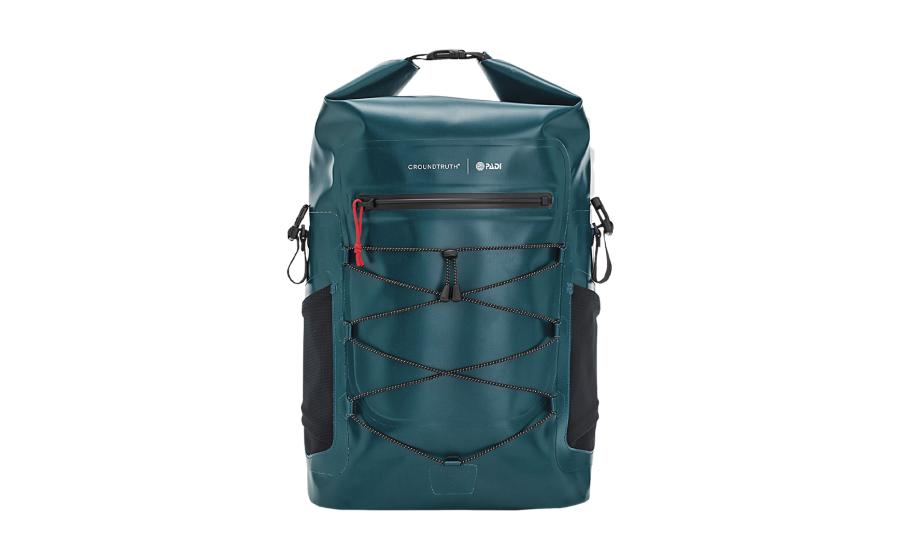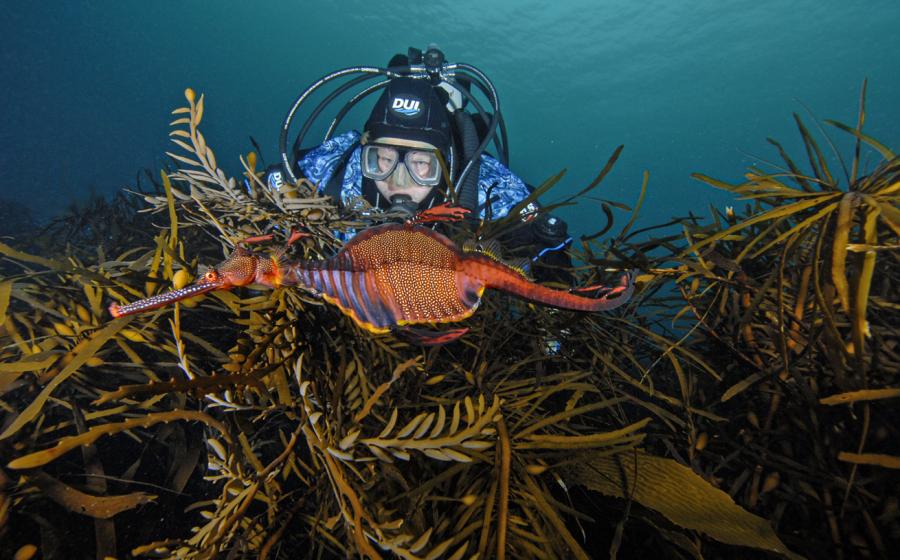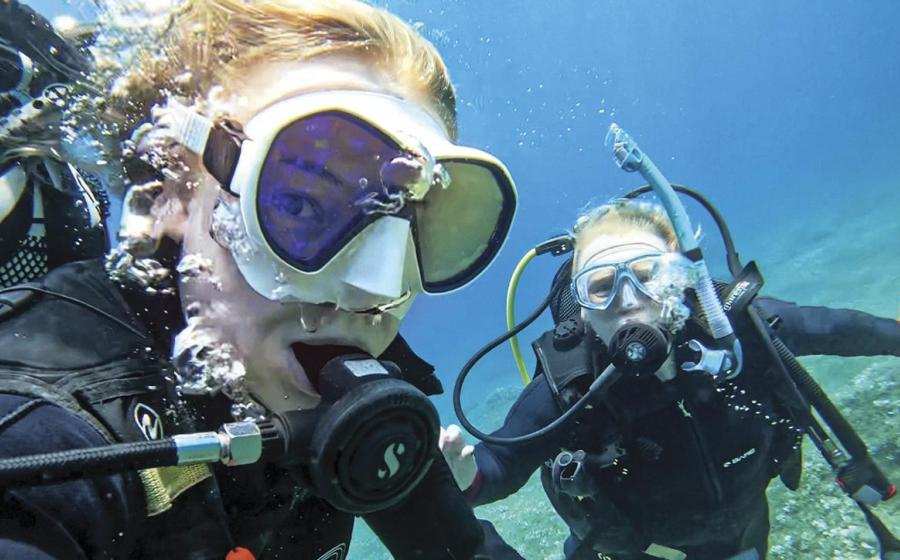Dominica Dive Travel Guide: The Natural

Emerald Pools, Dominica
Michele Westmorland
I’m with a small group diving Scott’s Head Pinnacle, a popular seamount just off Scott’s Head, the promontory on Dominica’s southwestern tip that cups the southern end of Soufrière Bay. We actually began the dive west of the pinnacle at a site called Swiss Cheese, named for its myriad diver-size openings in the reef. After meandering in and out of several arches and swim-throughs, we glide over a small spire and arrive at the entrance to the pinnacle’s best-known archway: Two huge granite boulders that lean against each other to form a steeple-like grotto filled to the rafters with blackbar soldierfish. It’s a breathtaking formation so characteristic of Dominica: At every turn of this island’s dramatic sea- and landscape, an astonishing gift of nature awaits.
I get to Dominica the way every visitor does, aboard a small plane, because neither of the island’s two airports accommodates large passenger jets. The DeHavilland Dash 8 turboprop drops through the clouds on its noisy approach to the 29-mile-long by 16-mile-wide island.
Dominica is strikingly vertical, its angled, sharp peaks covered in lush rain forest—think Jurassic Park minus the meat-eating dinosaurs that treat planes this size like playthings. The island is the tallest in the Caribbean; Dominica’s highest peak, Morne Diablotin, soars 4,747 feet into the sky. Indigenous Carib Indians called their home Waitikubuli, which means “tall is her body.”
After Christopher Columbus’s second visit to the New World, he described Dominica to Ferdinand and Isabella by crumpling a sheet of paper and tossing it on the table. Neither description really captures the spectacular beauty of the island’s terrain. Jungly-green mountains plunge straight into the sapphire-blue sea, creating a dramatic underwater bottomography formed from the same violent volcanic forces that gave birth to the island’s rugged interior.
Dominica’s western shore faces the calm waters of the Caribbean, its eastern side the crashing waves of the Atlantic. The most popular diving is found along the island’s western coast—with sites clustered in the south, mid-island and north—but operators take divers to the Atlantic side when conditions are right. My weeklong stay affords me the chance to sample the diving all along the Caribbean coast.
Soufrière, Scott’s Head and the Southwest
Off Dominica’s southwestern end, Soufrière Bay is actually the submerged crater of an ancient volcano. Divers can explore the shallow reefs that line the rim of the caldera or drop down on its volcanic flanks for a deeper profile. The bay, protected from the Atlantic by Scott’s Head, is home to many of the island’s most visited dive sites, especially just off the scalloped coastline near the town of Soufrière. Operators also take divers to the sites bunched around Scott’s Head, but outside the bay, west of the headland, sites like Scott’s Head Pinnacle and Cashacrou are more prone to current and surge.
Dangleben’s Pinnacles is typical of the diving inside the bay, though the number of deep-water seamounts grouped here (five) and their varied habitats make it a spot that divers visit more than once during a week of bubble-blowing. The morning we dive it, we drop down to a shelf in 60 feet of water before circling upward. Sponges, gorgonians, and black, plate and finger corals are gathered in garden-like arrangements. We swim past eye-catching azure vase sponges and huge, 100-year-old barrel sponges crowned by filter-feeding golden crinoids. To top off the dive, a green sea turtle bobs on the surface as we clamber back aboard the boat.
Salisbury and Mid-Island
The diving off Dominica’s mid-island region (mostly off Salisbury Beach, Grande Savane, St. Joseph’s and Tarou) features patch reefs sloping down to steep walls at sites like Rodney’s Rock, Castaways Reef and Nose Reef. Larger blue-water pelagics like spotted eagle rays and rainbow runners that are largely absent from southern sites can be encountered here, and we’ve been told to keep an eye out for barracuda. But what excites my buddy, photographer Clay Wiseman, and me is the small stuff and the assortment of rare and elusive creatures like batfish and seahorses that can be found very close to shore at sites you won’t find named on any dive map. At Nose Reef we drift lazily atop the reef, while Clay photographs a good-sized school of silvery bogas. When Clay slips over the reef’s edge to explore the nose-like protrusions sticking out from the wall, I spot a solitary barracuda that has pulled up, like a sleek sports car, just outside the perimeter of the tightly bunched bogas. They don’t seem overly concerned, and the barracuda eventually cruises out of sight.
Cabrits National Park and the Northwest
By the time we dive the northwest, ocean swells have churned up the bottom and muddied the water clarity. The dive sites here are located in Douglas and Prince Rupert bays, which are separated by Cabrits National Park, a chunky peninsula that sticks out from the mainland like a fat thumb.
Because of the conditions, we veto making the trip to Toucari Caves, which is usually an extraordinary dive — its honeycombed caverns (dripping with black coral) are so varied that it’s easy to lose track of your bottom time. Our next choice, Rose Garden, located in the protected shelter of Douglas Bay and home to a huge, pristine boulder star coral, also suffers from below-average vis, so we head to the pier at the Cabrits Cruise Ship Berth.
Dive operators have dubbed this site Pole to Pole. In the sand flats, Clay photographs two batfish, a species that is rare elsewhere in the Caribbean, but is found more frequently in Dominica’s waters. Nearby, a squadron of flying gurnards, seven of them, dig for food in the sand until we disturb them—they spread their large, fan-like pectoral fins and swim away. Pole to Pole turns out to be one of the most productive sites we dive.
Even given the least promising of conditions, the sites off Dominica deliver enough action and variety to satisfy the been-there-done-that crowd. The island is an all-natural wonder.
Calling All Whales
Dominica's location in the Eastern Caribbean means it's ideally located for migrating whales.
Reggie Prosper’s briefing, before every sperm whale encounter, begins with a disclaimer: “First, we are not guaranteed that we will see whales,” followed by an optimistic note: “But we are 95 percent guaranteed to see a whale.”
We leave Dive Dominica’s dock aboard the sturdy catamaran Barana. The cat heads out about a mile, and Reggie and the crew drop their makeshift hydrophone into the water. The receiver is inside a salad bowl wrapped in neoprene from an old wetsuit, then attached to a pole that is in turn rigged to a Radio Shack transmitter. “It’s very technologically advanced,” the boat captain jokes. Reggie listens for the clicking sounds—like fingers snapping—that a sperm whale makes. He twirls the hydrophone north, east,
south and west. No clicks, so the boat captain changes course.
For three-and-a-half hours, we head this way and that, like a carload of partygoers looking for an unfamiliar address. Finally, the hydrophone picks up the telltale clicks, and the captain turns Barana toward the sound. Reggie shouts, “There she blows!” and in moments, we are next to four good-sized sperm whales, females blowing at the surface, shoulder to shoulder.
Then a huge male’s back breaks the surface. He’s at least a 30-footer, and he seems to be shepherding his harem. Everyone has broken out into whale-size grins.
Make It Happen: Sperm whales are common off Dominica from October to March, and various dive operators take groups on weekly excursions.
Creole Flavors
Best places to try Dominica's spicy home-grown cuisine
Creole cooking is fairly simple—staples like yams, breadfruit, plantains and dasheens (a variety of taro) are served with fish, chicken or goat. What gives the food its heat? A liberal sprinkling of locally made hot pepper sauce.
Roger’s Bar In the village of Scott’s Head, the open-air cafe run by Roger Caesar offers succulent, falling-off-the-bone chicken stew and fish dishes.
Papillote Rainforest Restaurant Close to Wotten Waven, the chef here whips up Creole-style, locally caught fish and side dishes made from locally grown produce.
Mousehole Snackette Order delicious curry-flavored chicken or fish rotis (similar to a burrito) in downtown Roseau at the Mousehole.
Chez La Doudou Beach Bar This festive little bar, located on the property of East Carib Divers on Salisbury Beach, features seating on a small deck overlooking the sea. Beatrice Contrera prepares dishes with a French flair and homemade pizzas on Sunday nights.
Picard Beach Cottages Just south of Portsmouth on the northwestern coast, this resort has open-air dining on the water. The menu is quite varied, from pasta to seafood.
Roseau’s Public Market Don’t miss the Saturday morning farmer’s market along Roseau’s riverfront, where you can buy locally grown fruit or spices like nutmeg and cinnamon.
Dive Operator: Buddy Dive on Dominica at the Fort Young Hotel in Rouseau.
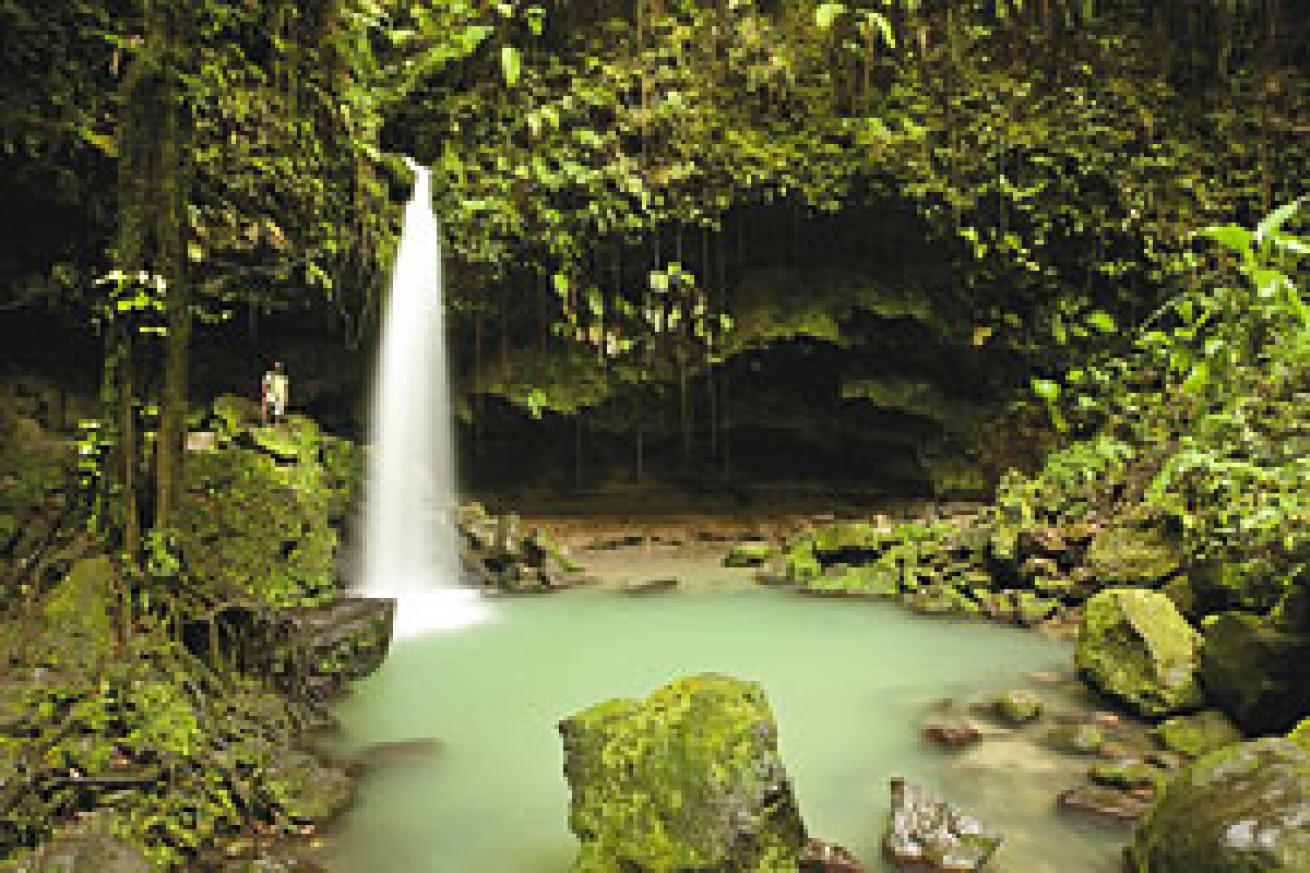
Michele Westmorland
I’m with a small group diving Scott’s Head Pinnacle, a popular seamount just off Scott’s Head, the promontory on Dominica’s southwestern tip that cups the southern end of Soufrière Bay. We actually began the dive west of the pinnacle at a site called Swiss Cheese, named for its myriad diver-size openings in the reef. After meandering in and out of several arches and swim-throughs, we glide over a small spire and arrive at the entrance to the pinnacle’s best-known archway: Two huge granite boulders that lean against each other to form a steeple-like grotto filled to the rafters with blackbar soldierfish. It’s a breathtaking formation so characteristic of Dominica: At every turn of this island’s dramatic sea- and landscape, an astonishing gift of nature awaits.
I get to Dominica the way every visitor does, aboard a small plane, because neither of the island’s two airports accommodates large passenger jets. The DeHavilland Dash 8 turboprop drops through the clouds on its noisy approach to the 29-mile-long by 16-mile-wide island.
Dominica is strikingly vertical, its angled, sharp peaks covered in lush rain forest—think Jurassic Park minus the meat-eating dinosaurs that treat planes this size like playthings. The island is the tallest in the Caribbean; Dominica’s highest peak, Morne Diablotin, soars 4,747 feet into the sky. Indigenous Carib Indians called their home Waitikubuli, which means “tall is her body.”
After Christopher Columbus’s second visit to the New World, he described Dominica to Ferdinand and Isabella by crumpling a sheet of paper and tossing it on the table. Neither description really captures the spectacular beauty of the island’s terrain. Jungly-green mountains plunge straight into the sapphire-blue sea, creating a dramatic underwater bottomography formed from the same violent volcanic forces that gave birth to the island’s rugged interior.
Dominica’s western shore faces the calm waters of the Caribbean, its eastern side the crashing waves of the Atlantic. The most popular diving is found along the island’s western coast—with sites clustered in the south, mid-island and north—but operators take divers to the Atlantic side when conditions are right. My weeklong stay affords me the chance to sample the diving all along the Caribbean coast.
Soufrière, Scott’s Head and the Southwest
Off Dominica’s southwestern end, Soufrière Bay is actually the submerged crater of an ancient volcano. Divers can explore the shallow reefs that line the rim of the caldera or drop down on its volcanic flanks for a deeper profile. The bay, protected from the Atlantic by Scott’s Head, is home to many of the island’s most visited dive sites, especially just off the scalloped coastline near the town of Soufrière. Operators also take divers to the sites bunched around Scott’s Head, but outside the bay, west of the headland, sites like Scott’s Head Pinnacle and Cashacrou are more prone to current and surge.
Dangleben’s Pinnacles is typical of the diving inside the bay, though the number of deep-water seamounts grouped here (five) and their varied habitats make it a spot that divers visit more than once during a week of bubble-blowing. The morning we dive it, we drop down to a shelf in 60 feet of water before circling upward. Sponges, gorgonians, and black, plate and finger corals are gathered in garden-like arrangements. We swim past eye-catching azure vase sponges and huge, 100-year-old barrel sponges crowned by filter-feeding golden crinoids. To top off the dive, a green sea turtle bobs on the surface as we clamber back aboard the boat.
Salisbury and Mid-Island
The diving off Dominica’s mid-island region (mostly off Salisbury Beach, Grande Savane, St. Joseph’s and Tarou) features patch reefs sloping down to steep walls at sites like Rodney’s Rock, Castaways Reef and Nose Reef. Larger blue-water pelagics like spotted eagle rays and rainbow runners that are largely absent from southern sites can be encountered here, and we’ve been told to keep an eye out for barracuda. But what excites my buddy, photographer Clay Wiseman, and me is the small stuff and the assortment of rare and elusive creatures like batfish and seahorses that can be found very close to shore at sites you won’t find named on any dive map. At Nose Reef we drift lazily atop the reef, while Clay photographs a good-sized school of silvery bogas. When Clay slips over the reef’s edge to explore the nose-like protrusions sticking out from the wall, I spot a solitary barracuda that has pulled up, like a sleek sports car, just outside the perimeter of the tightly bunched bogas. They don’t seem overly concerned, and the barracuda eventually cruises out of sight.
Cabrits National Park and the Northwest
By the time we dive the northwest, ocean swells have churned up the bottom and muddied the water clarity. The dive sites here are located in Douglas and Prince Rupert bays, which are separated by Cabrits National Park, a chunky peninsula that sticks out from the mainland like a fat thumb.
Because of the conditions, we veto making the trip to Toucari Caves, which is usually an extraordinary dive — its honeycombed caverns (dripping with black coral) are so varied that it’s easy to lose track of your bottom time. Our next choice, Rose Garden, located in the protected shelter of Douglas Bay and home to a huge, pristine boulder star coral, also suffers from below-average vis, so we head to the pier at the Cabrits Cruise Ship Berth.
Dive operators have dubbed this site Pole to Pole. In the sand flats, Clay photographs two batfish, a species that is rare elsewhere in the Caribbean, but is found more frequently in Dominica’s waters. Nearby, a squadron of flying gurnards, seven of them, dig for food in the sand until we disturb them—they spread their large, fan-like pectoral fins and swim away. Pole to Pole turns out to be one of the most productive sites we dive.
Even given the least promising of conditions, the sites off Dominica deliver enough action and variety to satisfy the been-there-done-that crowd. The island is an all-natural wonder.
Calling All Whales
Dominica's location in the Eastern Caribbean means it's ideally located for migrating whales.
Reggie Prosper’s briefing, before every sperm whale encounter, begins with a disclaimer: “First, we are not guaranteed that we will see whales,” followed by an optimistic note: “But we are 95 percent guaranteed to see a whale.”
We leave Dive Dominica’s dock aboard the sturdy catamaran Barana. The cat heads out about a mile, and Reggie and the crew drop their makeshift hydrophone into the water. The receiver is inside a salad bowl wrapped in neoprene from an old wetsuit, then attached to a pole that is in turn rigged to a Radio Shack transmitter. “It’s very technologically advanced,” the boat captain jokes. Reggie listens for the clicking sounds—like fingers snapping—that a sperm whale makes. He twirls the hydrophone north, east, south and west. No clicks, so the boat captain changes course.
For three-and-a-half hours, we head this way and that, like a carload of partygoers looking for an unfamiliar address. Finally, the hydrophone picks up the telltale clicks, and the captain turns Barana toward the sound. Reggie shouts, “There she blows!” and in moments, we are next to four good-sized sperm whales, females blowing at the surface, shoulder to shoulder.
Then a huge male’s back breaks the surface. He’s at least a 30-footer, and he seems to be shepherding his harem. Everyone has broken out into whale-size grins.
Make It Happen: Sperm whales are common off Dominica from October to March, and various dive operators take groups on weekly excursions.
Creole Flavors
Best places to try Dominica's spicy home-grown cuisine
Creole cooking is fairly simple—staples like yams, breadfruit, plantains and dasheens (a variety of taro) are served with fish, chicken or goat. What gives the food its heat? A liberal sprinkling of locally made hot pepper sauce.
Roger’s Bar In the village of Scott’s Head, the open-air cafe run by Roger Caesar offers succulent, falling-off-the-bone chicken stew and fish dishes.
Papillote Rainforest Restaurant Close to Wotten Waven, the chef here whips up Creole-style, locally caught fish and side dishes made from locally grown produce.
Mousehole Snackette Order delicious curry-flavored chicken or fish rotis (similar to a burrito) in downtown Roseau at the Mousehole.
Chez La Doudou Beach Bar This festive little bar, located on the property of East Carib Divers on Salisbury Beach, features seating on a small deck overlooking the sea. Beatrice Contrera prepares dishes with a French flair and homemade pizzas on Sunday nights.
Picard Beach Cottages Just south of Portsmouth on the northwestern coast, this resort has open-air dining on the water. The menu is quite varied, from pasta to seafood.
Roseau’s Public Market Don’t miss the Saturday morning farmer’s market along Roseau’s riverfront, where you can buy locally grown fruit or spices like nutmeg and cinnamon.
Dive Operator: Buddy Dive on Dominica at the Fort Young Hotel in Rouseau.

